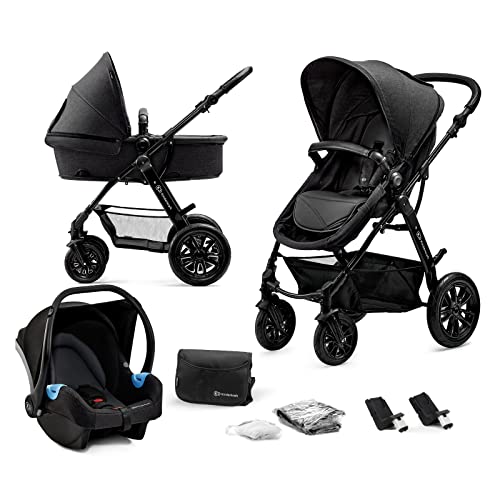Prams and Pushchairs: A Comprehensive Guide for New Parents
Navigating the world of baby transport can be overwhelming for new moms and dads, especially when it concerns selecting in between prams and pushchairs. Each alternative offers distinct benefits and restrictions, implying that making an informed choice is essential. This short article intends to offer a thorough understanding of prams and pushchairs, their differences, features to think about, and suggestions for choosing the best one.
Understanding the Basics: Prams vs. Pushchairs
Prams and pushchairs are terms often used interchangeably, however they refer to various kinds of baby transport systems.
Definitions:
- Prams: Traditionally created for newborns and babies, prams have a big, fully flat bassinet that enables optimum convenience and safety throughout early stages of a kid's life.
- Pushchairs: Designed for older babies and toddlers, pushchairs usually have an upright seat that appropriates for kids who can support their head and neck. They frequently include adjustable recline alternatives.
Key Differences
| Feature | Pram | Pushchair |
|---|---|---|
| Style | Flat bassinet | Upright seat |
| Age Suitability | Newborn to around 6 months | 6 months to 4 years |
| Mobility | Usually much heavier, less foldable | Often light-weight and foldable |
| Comfort | Comfortable for newborns, tight fit | Adjustable, can be reclined |
| Use | Suitable for walks and leisure | Versatile for daily activities and travel |
Functions to Consider When Choosing Prams and Pushchairs
Safety Features
- Harness systems (5-point vs. 3-point)
- Braking systems (foot-operated vs. hand-operated)
- Stability and strength of the frame
Weight and Portability
- Consider the weight of the pram or pushchair
- Search for a model that folds easily for transportation
Size and Storage
- Check measurements for fitting through entrances and in automobile trunks
- Search for extra storage options like baskets or pockets
Comfort
- Cushioned seats and adjustable recline positions
- Suspension systems for smoother rides on rough surfaces
Weather Protection
- UV security in sunshades
- Choices for rain covers and windscreens
Wheels and Maneuverability
- Wheel size and type (fixed vs. swivel)
- Suspension systems that aid handling and convenience
Durability
- Models that convert from pram to pushchair
- Stronger frames that can accommodate growing kids
Popular Types of Prams and Pushchairs
When thinking about prams and pushchairs, moms and dads typically discover numerous styles catering to particular needs. Here are some popular types:
1. Standard Prams/Pushchairs
These are excellent all-rounders, created for everyday usage with a sturdy frame and ample storage area. They are typically adjustable and can deal with different terrains.
2. Travel Systems
These include a safety seat and a stroller that can be utilized together, making it simple to transfer the baby from the automobile to the pram without waking them up.
3. Umbrella Strollers
These are light-weight and foldable, perfect for fast getaways and travel. While practical, they typically lack a few of the security and convenience features discovered in much heavier designs.
4. All-Terrain Strollers
Created for off-road adventures, these strollers have bigger wheels and a more rugged frame, making them ideal for active households.
Picking the Right Pram or Pushchair
When selecting the best pram or pushchair, moms and dads need to take the following steps:
- Assess Lifestyle Needs: Consider how you will use the pram or pushchair (everyday walks, travel, unequal terrain) and select appropriately.
- Test Drive: It's useful to physically evaluate the designs at the store, checking for managing, comfort, and weight.
- Research Brands: Look at evaluations and suggestions from other parents about particular brand names or models.
- Think About Future Needs: Think ahead to make sure the option will work as the kid grows. Top Pram use versatility.
- Budget: Set a spending plan however likewise aspect in quality and longevity. Sometimes investing more initially can save costs in the long run.
Often Asked Questions
What is the best age to start using a pushchair?
The majority of pushchairs can be used for babies from about 6 months old when they can sufficiently support their heads and necks. Ensure to check the producer's requirements.
Are prams appropriate for newborns?
Yes, prams are preferably suited for newborns due to their flat bassinet style, offering a comfortable and safe and secure environment.
How do I clean a pram or pushchair?
Always refer to the producer's guidelines, but many covers are removable and can be washed. Clean down the frame with a damp fabric and prevent utilizing severe chemicals.
Can I use a pram or pushchair on public transport?
Various models vary in size; lightweight and foldable choices are normally preferable for buses or trains. However, constantly examine for transportation guidelines in your location.
For how long can I utilize a pram or pushchair?
It generally depends upon the weight limit specified by the producer, frequently between 15-50 pounds, or up until your kid no longer wishes to be pressed.
Selecting in between a pram and a pushchair is a substantial decision that accommodates the way of life and requirements of both the moms and dad and the kid. By understanding the distinctions between the 2, examining important functions, and picking the ideal design, moms and dads can guarantee they have a safe, comfy, and practical transportation option for their kids.
Equipping oneself with understanding offers parents not only comfort but also the confidence to make the best option for their kid's early adventure into the world. Different way of lives require different solutions, so making the effort to research study and test what fits can relieve some of the tensions that come with brand-new parenthood. Delighted walking!

